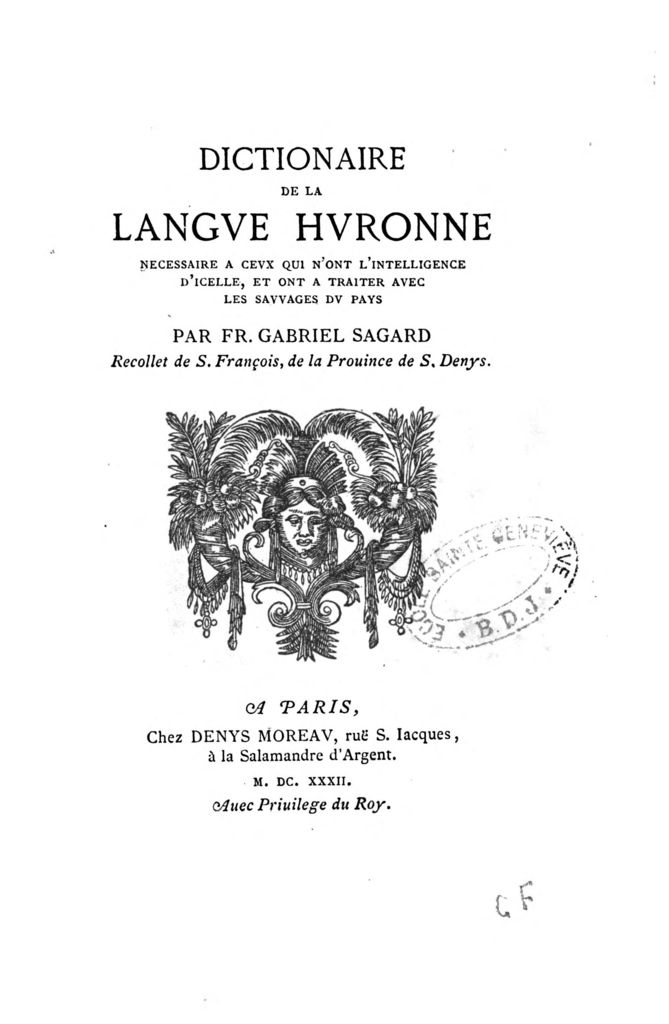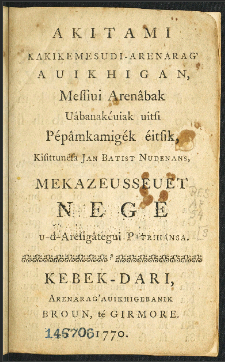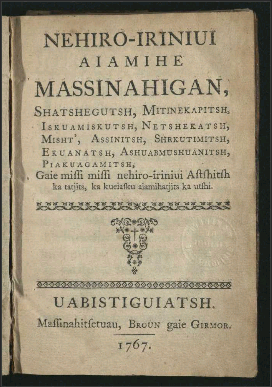bloc_article_content
American Indian Languages in New France
The North American territory claimed by France was always a multilingual space – a huge tract of North America populated by indigenous peoples speaking languages belonging primarily to the Algonquian and Iroquoian families, but also including speakers of Eskimo-Aleut, Siouan, Uto-Aztecan, Caddoan, and Muskogean languages as well as various isolates
In 1728, the Jesuit Pierre-Michel Laure composed an obituary for Pēšāpanuhkwēw (baptised as Marie Utchiuanich, using her father’s name):
I, Père Pierre Laure, S. J., have duly buried in the Chekutimi cemetery Marie Utchiuanich wife of Nicolas Peltier, who, after an illness of one year, fortified beforehand by all the sacraments, died as piously as she had lived. She is missed and will always be missed by all of us. […]. I was taught the Montagnais language by her and was helped in writing prayers and a rudimentary dictionary. [She was] worthy of a longer epitaph and, had God been pleased, a longer life; she did not, as I believe, complete her fiftieth year (Hébert 1976: 212; translation courtesy of Dr. Walter Redmond).
Laure had arrived in Chicoutimi eight years. As with most of the territory claimed by France in North America, the region served by the Chicoutimi mission was populated almost entirely by speakers of an indigenous language (in this case, Nēhirawēwin - a dialect of the Cree-Innu-Naskapi-Atikamekw continuum). His success dependent on being able to effectively work in this language, he would produce the prayers and dictionary mentioned above, as well as a hymnal, a guide to confession, and a series of maps noted for their inclusion of hundreds of indigenous-language place names.
The North American territory claimed by France was always a multilingual space – a huge tract of North America populated by indigenous peoples speaking languages belonging primarily to the Algonquian and Iroquoian families, but also including speakers of Eskimo-Aleut, Siouan, Uto-Aztecan, Caddoan, and Muskogean languages as well as various isolates. Even in areas of intensive French settlement, indigenous speech communities remained for the duration of the French colony. Further, the French slave trade brought speakers of more distant indigenous languages, like those of the Sioux and Pawnee, to the principal areas of French settlement. For this reason, a variety of indigenous languages would have been heard spoken on the streets of the Montreal and Quebec throughout the French colonial period.
When the French first arrived in north-eastern North America, they were arriving with no knowledge of the region’s languages. Following Cartier’s brief encounter with Saint-Lawrence Iroquoians in the 16th century, the initial linguistic encounter was shaped by vernacular industry: the regular presence of Basque whalers and fishers led to the development of trade pidgins in the Saint Lawrence River Valley and on the east coast. French missionaries and colonists arriving in the early 17th century noted the existence of these pidgins, which surely facilitated successful communication during the initial establishment of the French colony at Quebec.
As the French presence intensified, successful communication with indigenous peoples was particularly important for fur traders, for diplomats and military leaders, and for missionaries hoping to win converts. Missionaries devoted significant effort to learning and documenting indigenous languages, and French missionary manuscripts represent the earliest written records for many of the region’s Algonquian and Iroquoian languages. Unlike the Spanish and English, the French colony would have no printing press, and therefore missionaries were unable to print the grammars, dictionaries, prayer books, hymnals, and sermons they were producing. The copying of these manuscripts became a key part of a Jesuit missionary language study.
By the mid-seventeenth century French Jesuit missionaries were aware of the existence of two language families – those related to languages they referred to as Algonquin and Montagnais which were spoken in the Saint Lawrence river valley, and those related to the languages spoken by the Haudenosaunee (the Iroquois Confederacy) and Wendat (Huron). Today these are referred to as Algonquian and Iroquoian languages. The two Algonquian languages, Algonquin and Montagnais, belonged to dialect continua that extended far to the west - the previously mentioned Cree-Innu-Naskapi-Atikamekw dialect continuum and the Anishinabemowin continuum. These languages were also closely related to languages the French would encounter south of the Great Lakes in the Illinois country. Because of this, French knowledge of these languages facilitated exploration north, west, and south of the Great Lakes and helped secure important alliances with the Algonquian-speaking communities in these regions.
In general, indigenous speech communities remained stable through the French colonial period – there is no evidence for the widespread bilingualism that would emerge in the 19th and 20th centuries. The French presence, however, would have an influence on the historical development of many of the region’s indigenous languages. Languages spoken in communities disrupted by warfare and the slave trade would have been negatively affected – in some cases, languages like that of the Wendat that were once widely spoken by large and influential communities would see their population and influence significantly reduced. Others, like the Algonquian languages spoken by close allies may have seen their prestige increase as they benefitted from relationships with the French. Some may have even become lingua francas in areas where French trade and military alliances assumed great importance. Further, contact with French society and technology introduced new vocabulary – much of which spread within dialect continua, and some of which continues to exist to this day. Similarly, there is little evidence for widespread bilingualism among the French population – the use and mastery of indigenous languages would remain an area of expertise for those involved in the fur trade and missionary work.
Following the end of the French colonial period, the British administration would establish a printing press at Quebec City. The French Jesuit Jean-Baptiste de la Brosse, working among the same Nēhirawēwin-speaking communities served by Pierre-Michel Laure, would finally be able to print materials in the language. His Nēhirawēwin prayer book, the Nehiro-Iriniui Aiamihe Massinahigan (1767), would be one of the first books printed in Canada and was largely copied from the book of prayers produced by Pēšāpanuhkwēw and Laure. La Brosse’s printed works would find acceptance, helping to facilitate literacy among many in the region and influencing the contemporary adoption of a standard orthography for the Innu language. Other communities, like the Wendat and Abenaki communities close to Quebec City, and the Miami community in Oklahoma, have used French Jesuit sources to inform language revitalization efforts. Because of their breadth and quality, indigenous language manuscripts produced during the French period continue to provide important historical perspectives on many of North America’s indigenous languages.
Published in may 2021








